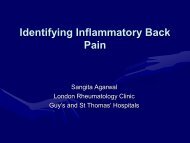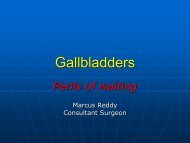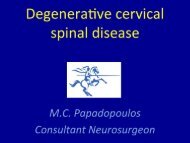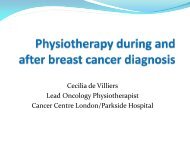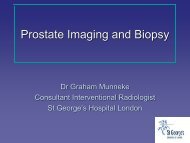Management of Low Back Pain - Dr Prabhu ... - Parkside Hospital
Management of Low Back Pain - Dr Prabhu ... - Parkside Hospital
Management of Low Back Pain - Dr Prabhu ... - Parkside Hospital
You also want an ePaper? Increase the reach of your titles
YUMPU automatically turns print PDFs into web optimized ePapers that Google loves.
<strong>Management</strong> <strong>of</strong> <strong>Low</strong> back pain<br />
<strong>Dr</strong> <strong>Prabhu</strong> Gandhimani<br />
MD;FRCA;FIPP;FFPMRCA<br />
Kingston <strong>Hospital</strong><br />
Queen Mary’s <strong>Hospital</strong>, Roehampton<br />
New Victoria ,<strong>Parkside</strong> <strong>Hospital</strong> and<br />
Putney ( NHS Choose and Book)
Incidence<br />
• About 80% will suffer with low back pain at some<br />
point in their life<br />
• 90% <strong>of</strong> these attacks are self limiting and resolve<br />
within 1 months.<br />
• 30% <strong>of</strong> patients report moderate pain at 1 year after<br />
the initial episode<br />
• 1 in 5 report substantial limitations in activity.<br />
• The 1 year prevalence <strong>of</strong> chronic back pain is 6-15%
Economic Burden<br />
• Health care costs- £1.6 billion/year<br />
• Equivalent to 1-2% <strong>of</strong> GDP <strong>of</strong> UK<br />
• Second commonest reason for long term<br />
sickness<br />
• 1% <strong>of</strong> popln are <strong>of</strong>f sick at any one day.
Causes <strong>of</strong> <strong>Back</strong> pain- evolution
Causes <strong>of</strong> back pain<br />
• Lack <strong>of</strong> exercise<br />
• Poor posture Poor<br />
posture<br />
• Manual labor<br />
• Osteoporosis<br />
• Genetic
Poor posture
The first question…<br />
Is the back pain coming from the back<br />
Abdomen<br />
Pelvis<br />
Hip<br />
GIT, Urinary tract, Vascular<br />
Genito-urinary<br />
Functional pain
Is there a serious systemic disease “Redflags”<br />
Disease<br />
• Vertebral fracture<br />
• Vertebral metastasis<br />
• Inflammatory arthritis<br />
• Infections<br />
• Cauda Equina<br />
History<br />
• Age 50<br />
• H/o Trauma<br />
• H/o Malignancy<br />
• H/o Loss <strong>of</strong> weight/appetite<br />
• Poly arthritis<br />
• Unremitting night time pain<br />
• Fever, Night sweats<br />
• IV drug use<br />
• H/O steroid use<br />
• Bladder / Bowel Disturbance
Is there any psychosocial distress that hinders<br />
recovery/ amplifies symptoms<br />
“Yellow flags”<br />
– Belief that back pain is potentially disabling<br />
– Fear avoidance behaviour with reduced activity<br />
– Tendency to low mood or withdrawal from social<br />
interaction<br />
– An expectation that passive treatment rather than<br />
active participation will help.
Etiology<br />
Definitive pathological diagnosis is made only in 15%<br />
• Triage -<br />
– Simple Mechanical LBP-<br />
80 to 90%<br />
– Nerve root (radicular)<br />
pain“sciatica”-5 to 15%<br />
– Serious spinal pathology<br />
– 1 to 2%
Simple Mechanical LBP( 80 – 90%)<br />
• Idiopathic (65%-70%)<br />
– Muscle strain or<br />
ligamentous injury<br />
• Degenerative disc<br />
• Facet joint disease<br />
• Congenital deformity<br />
(scoliosis, kyphosis,<br />
transitional vertebrae)<br />
• osteoporosis
Simple mechanical back pain<br />
(Ordinary backache)<br />
•Clinical presentation usually at age 20-55 years<br />
•Lumbosacral region, buttocks, and thighs<br />
•<strong>Pain</strong> is mechanical in nature<br />
•Varies with physical activity<br />
•Varies with time<br />
•Patient well
Nerve root pain(5-15%)<br />
• Annular tear<br />
• Herniated disc<br />
• Foraminal stenosis<br />
• Spinal stenosis<br />
• Epidural scar/<br />
adhesion<br />
• Infection (such as<br />
herpes zoster)
Nerve root pain<br />
•Unilateral leg pain is worse than back pain<br />
•<strong>Pain</strong> generally radiates to foot or toes<br />
•Numbness or paraesthesia in the same distribution<br />
•Nerve irritation signs<br />
‣Reduced SLR which reproduces leg pain<br />
•Motor, sensory, or reflex changes<br />
‣Limited to one nerve root
Chronic low back pain might be a case<br />
<strong>of</strong> mixed pain<br />
3<br />
37% <strong>of</strong> cases <strong>of</strong> chronic low back pain have a neuropathic component 2<br />
<strong>Low</strong> back pain with radiating pain to the leg (radiculopathy) is one<br />
<strong>of</strong> the most common variations <strong>of</strong> low back pain 3<br />
Screening tools can help to identify patients with<br />
neuropathic back pain - LANS,<strong>Pain</strong> Detect<br />
Typical causes <strong>of</strong> radiating pain 3,4<br />
Spinal<br />
canal stenosis<br />
Disc<br />
herniation<br />
Typical symptoms <strong>of</strong> radiating pain include: 2<br />
Electric<br />
shocks<br />
Burning<br />
Tingling<br />
or prickling<br />
NSAIDs do not generally have an effect on<br />
neuropathic pain 1
Leg pain<br />
Mechanical( referred)<br />
• Constant<br />
• Aching<br />
• Diffuse<br />
Neuropathic<br />
• Intermittent<br />
• Shooting,pins and<br />
needles,stabbing<br />
• Localised<br />
• No abnormal neurology<br />
• Usually above knee<br />
• May be abnormal<br />
• Usually below knee
Example <strong>of</strong> co-existing pain: herniated disc causing<br />
low back pain and lumbar radicular pain<br />
Nociceptive<br />
Neuropathic<br />
Activation<br />
<strong>of</strong> local<br />
nociceptors 1<br />
Ectopic discharges<br />
from nerve<br />
root lesion 3<br />
Lesion<br />
Constant ache, throbbing<br />
pain in the low back 2<br />
Patient presents<br />
with both types<br />
<strong>of</strong> pain<br />
Shooting, burning<br />
pain in the foot 2,3<br />
1. Brisby H. J Bone Joint Surg Am 2006;88 (Suppl 2):68–71; 2. McMahon SB and Koltzenburg M. Wall and Melzack’s<br />
Textbook <strong>of</strong> <strong>Pain</strong>. 5th ed. London: Elsevier; 2006; pg 1032; 3. Freynhagen R, Baron R. Curr <strong>Pain</strong> Headache Rep<br />
2009;13:185–90
When to Investigate<br />
• Possible serious spinal pathology( Redflags)<br />
• Non mechanical LBP<br />
• Targeted injections<br />
• Persistent mechanical LBP.
What Investigations<br />
• Xray – Fracture, metastasis<br />
• DEXA scan- osteoporosis<br />
• MRI- Nerve impingement<br />
• Bone scan- “ Bone activity”- Hot spots<br />
– Inflammatory arthritis<br />
– Metastasis<br />
• ESR- Increased in malignancy, inflammation
MRI Study<br />
To rule out sinister causes as opposed to finding the cause <strong>of</strong> back<br />
pain.<br />
• 98 asymptomatic patients<br />
• 52% had disc bulges<br />
• 27% had disc protrusions<br />
• 1% had disc extrusions (outside the annulus)<br />
• 14% had annular defects<br />
• 8% had facet pathology<br />
• 7% had spondylolithesis<br />
• 7% had stenosis (central or foraminal)<br />
Jensen<br />
NEJM July 1994
When To Refer<br />
• Serious spinal patholgy<br />
• Significant yellow flags<br />
• Persistant Neuropathic pain after 2to 4 weeks.<br />
• Progressive neurosigns.
<strong>Management</strong> options<br />
Conservative<br />
non-pharmacological<br />
Pharmacological<br />
<strong>Pain</strong><br />
<strong>Management</strong><br />
Interventional<br />
Functional<br />
rehabilitation<br />
Psychological
Implementing pain management<br />
strategies<br />
• Early implementation <strong>of</strong> an appropriate individual pain<br />
management strategy may result in quicker pain relief, and thus<br />
less disability, improved productivity and reduced economic<br />
burden 1<br />
Diagnosis<br />
Treatment <strong>of</strong> underlying conditions and symptoms<br />
Improved physical<br />
functioning<br />
Reduced pain<br />
Improved quality<br />
<strong>of</strong> sleep<br />
Improved<br />
psychological state<br />
Improved overall<br />
quality <strong>of</strong> life<br />
1. Haanpää ML et al. Am J Med 2009;122:S13–21.
Goals <strong>of</strong> the treatment<br />
Symptom<br />
Function
Simple mechanical back pain<br />
• 20% <strong>of</strong> patients need<br />
only reassurance<br />
• Early Physio-<strong>Back</strong> care<br />
advice<br />
• Encourage activity<br />
• Hurt is not equal to<br />
harm
<strong>Back</strong> Care
Simple mechanical backpain +/-<br />
referred leg pain- <strong>Dr</strong>ug<br />
• Tramadol – Opioid and seratonin<br />
reuptake inhibitor<br />
• Opioids: best used as part <strong>of</strong> a<br />
structured, multi-modal approach<br />
rather than unimodal therapy<br />
• Muscle relaxants- short course
Disease specific Etiology<br />
• Discogenic pain<br />
• Facetogenic pain<br />
• Spinal canal stenosis<br />
• Sacro iliac joint pain<br />
• Radiculopathy
Degenerative disc<br />
• 40 to 60% <strong>of</strong> back pain<br />
• <strong>Back</strong> pain increased<br />
with flexion activities<br />
• Early morning stiffness<br />
• Cant sit, stand, walk for<br />
too long<br />
• Treatment<br />
–
Facet Joint Arthritis<br />
• 15 to 40% <strong>of</strong> back pain<br />
• <strong>Pain</strong> more on extension<br />
and rotation<br />
• MRI non specific<br />
• Diagnostic: facet joint<br />
injections<br />
• Rhizotomy- long term<br />
relief
Spinal canal stenosis<br />
• <strong>Back</strong> pain and leg pain<br />
• Walking distance is<br />
progressively reduced<br />
• Leg becomes “jelly like”<br />
• Rest for few minutes<br />
improves<br />
• Treatment-<br />
– Epidural<br />
– Surgery
Sacro iliac Dysfunction<br />
• 1 to 20%<br />
• Increases with age<br />
• Pregnancy related<br />
• <strong>Pain</strong> in sacro iliac area<br />
might radiate to groin<br />
and thigh<br />
• Treatment<br />
– Physio<br />
– Injection<br />
– Surgery
Radiculopathy<br />
• Leg pain in dermatomal<br />
distribution<br />
• 85% will recover in 6<br />
weeks<br />
• Treatment<br />
– Anti neuropathic drugs<br />
– Epidural<br />
– Nerve root block<br />
– Surgery.
NICE – 2010<br />
Neuropathic <strong>Pain</strong>( Radiculopathy).<br />
First Line Treatment<br />
Amitryptiline or pregabalin.<br />
Amitryptiline helpful but side effects- try Imipramine<br />
or Nortryptiline<br />
Review- Second Line Treatment<br />
If first line was amitryptiline try<br />
pregabalin and vice versa.<br />
Try a combination <strong>of</strong> pregabalin<br />
and amitryptiline<br />
Third Line<br />
Consider tramadol.<br />
DO NOT start strong opioids<br />
Referral to pain clinic
Which drug..<br />
• Amitryptiline-<br />
– Start at 10 mg/day and increase 10mg/week to 75 mg/day.<br />
– Trial for atleast 4 weeks<br />
• Not Ideal<br />
– Patient above 65 years<br />
– Co existing Closed angle glaucoma, heart problems( atrial<br />
fibrillation)<br />
– Psychiatric medications and anti depressants<br />
– High dose <strong>of</strong> tramadol<br />
If amitryptiline is effective but patient is too drowsy<br />
-Imipramine, Nortryptiline
• Calcium channel blocker<br />
• 300mg tds increase<br />
300mg every 3 days to<br />
1800 mg max<br />
• Don’t combine with<br />
pregabalin.<br />
• Problems:<br />
– Unreliable absorption<br />
– <strong>Dr</strong>ug interaction<br />
– Warfarin-INR is increasedmonitor<br />
closely until dose<br />
is stabilised.<br />
Gabapentin
• Calcium channel blocker<br />
• Start with 75 mg BD 0r<br />
25 mg BD and increase<br />
the dose once in 3 days<br />
to 600mg/day<br />
• Trial for 4 weeks<br />
• Shown to improve REM<br />
sleep<br />
• Used for anxiety<br />
disorders<br />
Pregabalin
Epidurals<br />
• Transforaminal<br />
– Better success rate<br />
– Longer duration
Surgery Vs Epidural<br />
• Riew et al: 5 yr follow up, 55 randomized pts with radiculopathy;<br />
29 avoided surgery; 21 <strong>of</strong> 29 had f/u at 5 yrs: 17 <strong>of</strong> 21 still had no<br />
surgery<br />
• At 5 yr f/u all pts who avoided surgery: significant decreases in<br />
neurologic symptoms and back pain<br />
• Conclusion: majority <strong>of</strong> patients with lumbar radicular pain who<br />
avoid an operation for at least 1 year after receiving nerve root<br />
block with either bupiv + betamethasone will continue to avoid<br />
surgery at 5 yr
Failed <strong>Back</strong> Sugery Syndrome(FBSS)<br />
Epiduroplasty<br />
• <strong>Pain</strong> comes back after back surgery<br />
• Usually due to scar tissue<br />
• Exclude pain from another level.<br />
• Epidural adhesiolysis
Epidurogram- filling defect
Thank you<br />
www.controlpain.co.uk



